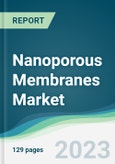Nanoporous membranes have purifying properties such as removing salts, microbes, organic molecules, and metallic ions. Thus, it is used in the treatment of wastewater containing minute contaminants. The rising demand for fresh water is causing demand for wastewater treatment plants and rising water desalination activities. These are increasing the adaptation rate. However, developing countries' low utilization of these membranes is a major challenge for market growth.
Various governments are increasingly seeking stringent regulations regarding wastewater treatment in industries utilizing massive amounts of water. Further, the application of nanoporous membranes has been increasing in the medical field. Furthermore, the leading market players are investing heavily in research and development (R&D) activities to expand the market growth.
In July 2023, The National Renewable Energy Laboratory (NREL) was working to develop novel membranes that filter out undesirable residues to analyze methods to decarbonize water and wastewater treatment. Researchers collaborated to improve the energy efficiency of desalination and water reuse technologies. This has been part of the $9 million National Alliance for Water Innovation (NAWI) Pilot Program funded by the U.S. Department of Energy’s Industrial Efficiency and Decarbonization Office.
Fuel cell performance can be improved with nanoporous carbon membranes. These membranes have mechanical strength, high chemical and thermal stability, durability, and the ability to withstand high pressure. Porous carbon membranes are relatively supportive of catalysts. They are characterized by high surface area, tuned pore size, designed porosity, multiple length scales, and different compositions. Hence, they are a good catalyst support for fuel cells.
NANOPOROUS MEMBRANES MARKET DRIVERS:
- Rising water desalination activities
Nanoporous Membrane Market Geographical Outlook
- The Asia Pacific region will dominate the nanoporous membrane market during the forecast period.
Reasons for buying this report::
- Insightful Analysis: Gain detailed market insights covering major as well as emerging geographical regions, focusing on customer segments, government policies and socio-economic factors, consumer preferences, industry verticals, other sub- segments.
- Competitive Landscape: Understand the strategic maneuvers employed by key players globally to understand possible market penetration with the correct strategy.
- Market Drivers & Future Trends: Explore the dynamic factors and pivotal market trends and how they will shape up future market developments.
- Actionable Recommendations: Utilize the insights to exercise strategic decision to uncover new business streams and revenues in a dynamic environment.
- Caters to a Wide Audience: Beneficial and cost-effective for startups, research institutions, consultants, SMEs, and large enterprises.
What do businesses use our reports for?
Industry and Market Insights, Opportunity Assessment, Product Demand Forecasting, Market Entry Strategy, Geographical Expansion, Capital Investment Decisions, Regulatory Framework & Implications, New Product Development, Competitive IntelligenceReport Coverage:
- Historical data & forecasts from 2022 to 2029
- Growth Opportunities, Challenges, Supply Chain Outlook, Regulatory Framework, Customer Behaviour, and Trend Analysis
- Competitive Positioning, Strategies, and Market Share Analysis
- Revenue Growth and Forecast Assessment of segments and regions including countries
- Company Profiling (Strategies, Products, Financial Information, and Key Developments among others)
The nanoporous membranes market is segmented and analyzed as follows:
- By Type
- Organic
- Inorganic
- Hybrid
- By Application
- Food Processing
- Water Treatment
- Biomedical
- Fuel Cells
- Others
- By Geography
- North America
- USA
- Canada
- Mexico
- South America
- Brazil
- Argentina
- Rest of South America
- Europe
- United Kingdom
- Germany
- France
- Italy
- Spain
- Rest of Europe
- Middle East and Africa
- Saudi Arabia
- UAE
- Rest of the Middle East and Africa
- Asia Pacific
- China
- India
- Japan
- South Korea
- Taiwan
- Thailand
- Indonesia
- Rest of Asia-Pacific
- North America
Table of Contents
Companies Mentioned
Some of the key companies profiled in this Nanoporous Membranes Market report include:- SmartMembranes GmbH
- Hydranautics
- InRedox
- SimPore
- Fraunhofer IKTS
- Synder Filtration
- NX Filtration BV
- Hunan Keensen Technology Co.
- Applied Membranes Inc.
- indoor GmbH
- MICRODYN-NADIR GmbH
- Osmotech Membranes Pvt Ltd
- Synder Filtration Inc.
- Toray Chemical Korea Inc.








